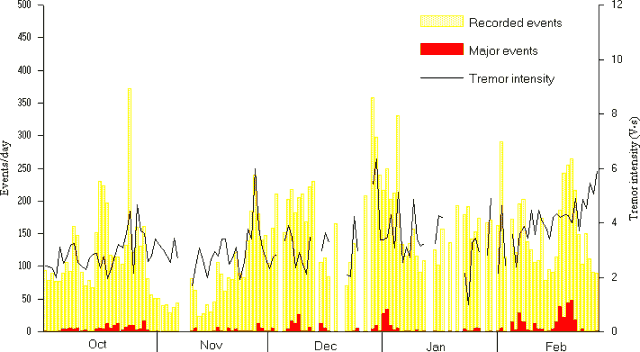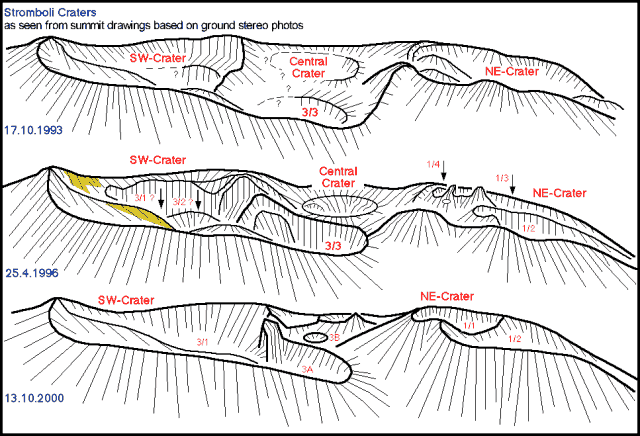Report on Stromboli (Italy) — April 2001
Bulletin of the Global Volcanism Network, vol. 26, no. 4 (April 2001)
Managing Editor: Richard Wunderman.
Stromboli (Italy) Variable seismicity during late 2000 and early 2001; spatter ejected above crater rims
Please cite this report as:
Global Volcanism Program, 2001. Report on Stromboli (Italy) (Wunderman, R., ed.). Bulletin of the Global Volcanism Network, 26:4. Smithsonian Institution. https://doi.org/10.5479/si.GVP.BGVN200104-211040
Stromboli
Italy
38.789°N, 15.213°E; summit elev. 924 m
All times are local (unless otherwise noted)
This report covers the period of October 2000-February 2001, describing variable activity since the last report (BGVN 25:08).
During the last three months of 2000 the seismic activity recorded by the University of Udine summit station (figure 63) remained in the low to moderate range, comparable to the previous months. Short periods were again characterized by a very low number of events. In particular, under 50 events were recorded on several days during the period 29 October-16 November. The period between late December 2000 and early January 2001 was characterized by slightly increased activity, with more than 250 events/day and a tremor intensity occasionally exceeding the value of 5 volt·seconds (V·s). A drop in seismicity at the end of January was followed by an increase in all parameters during February, with the number of seismic events again exceeding 250 per day on 20 and 21 February. "Major" seismic events, which caused instrument saturations, were concentrated in the period 17-22 February, with a peak of 44 and 48 saturating events on 20 and 21 February, respectively (figure 63). The tremor intensity showed a slower but steady growth, with values slightly over 2 V·s at the beginning of February, and near 6 V·s at the end of February.
Jürg Alean visited the volcano several times during mid-October 2000. On 10 October 2000, he observed about 6 eruptions/hour at the Southwest Crater (formerly called Crater 3), expelling large amounts of ash, sometimes almost hiding the glowing spatters that were being ejected to moderate heights. Vent 3B glowed intensely but never ejected lava. The Northeast Crater (formerly called Crater 1) had grown substantially over the last 7 years (figure 64) and was clearly separated into two pits, both of which were glowing at night with vent 1/1 glowing more strongly (vent clusters 1/1 and 1/2 are located on the floors of two coalesced depressions within the main Northeast Crater).
Alean reported that on 13 October Southwest Crater had more eruptions, ~10 per hour. Further, the kind of activity was different with a total absence of ash and a much longer duration of individual eruptions, some over 30 sec; spatters reached ~100 m above the crater rim. Activity had also increased at Northeast Crater: vent 1/1 delivered several eruptions/hour, mostly at an oblique angle towards Pizzo, while vent 1/2 erupted only weakly about once/hour. On 15 October, the sudden occurrence of very noisy degassing events heard several times at Stromboli village (e.g. 1106, 1125, 1145 and 1245) confirmed the variability of the eruptive activity during this week. No similar noises were heard later that day.
Roberto Carniel visited the summit crater area on 29 November 2000 and noted that there were significant changes since Alean's earlier visit in October. The hornito, located where the Central Crater (formerly called Crater 2) was located, was showing more intense degassing, and a new vent had opened between the hornito itself and vent 3B (figure 64), thus suggesting a renewal of the activity in this sector. This new vent, which Carniel labeled 3C, showed continuously puffing degassing, similar to vent 3B. At night, both were incandescent and continuously moderate spattering was observed at vent 3C, with small-sized spatters sometimes reaching the vent rim, landing on the crater terrace. Vent 3C also showed Strombolian eruptions, with vertically ejected, molten material reaching over 50 m above the rim.
Geological Summary. Spectacular incandescent nighttime explosions at Stromboli have long attracted visitors to the "Lighthouse of the Mediterranean" in the NE Aeolian Islands. This volcano has lent its name to the frequent mild explosive activity that has characterized its eruptions throughout much of historical time. The small island is the emergent summit of a volcano that grew in two main eruptive cycles, the last of which formed the western portion of the island. The Neostromboli eruptive period took place between about 13,000 and 5,000 years ago. The active summit vents are located at the head of the Sciara del Fuoco, a prominent scarp that formed about 5,000 years ago due to a series of slope failures which extends to below sea level. The modern volcano has been constructed within this scarp, which funnels pyroclastic ejecta and lava flows to the NW. Essentially continuous mild Strombolian explosions, sometimes accompanied by lava flows, have been recorded for more than a millennium.
Information Contacts: Roberto Carniel, Dipartimento di Georisorse e Territorio, Universitá di Udine, via Cotonificio 114, I-33100 Udine, Italy; Jürg Alean, Rheinstrasse 6, CH-8193 Eglisau, Switzerland; Stromboli On-line website, maintained by Alean and Carniel (URL: http://www.swisseduc.ch/stromboli/).



